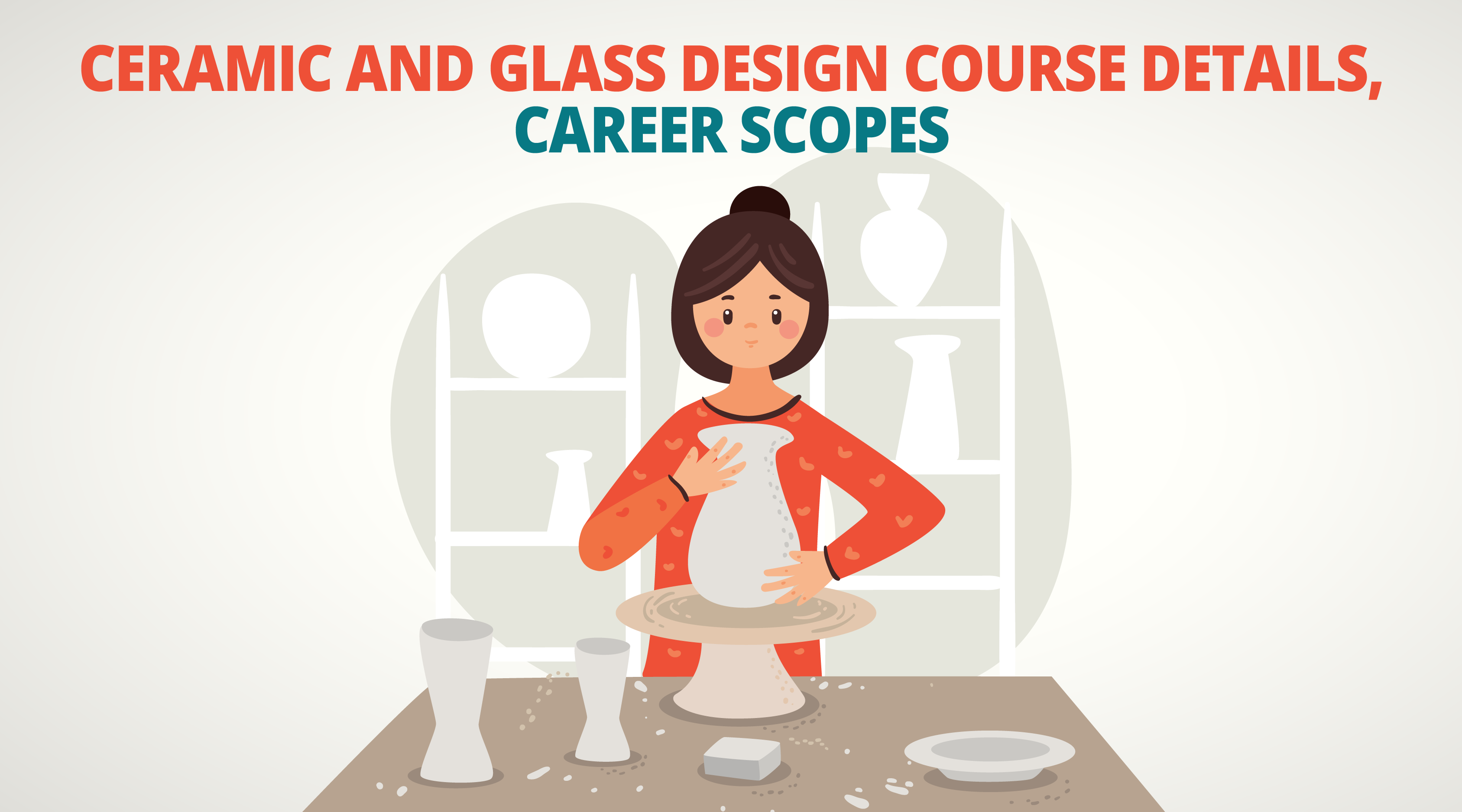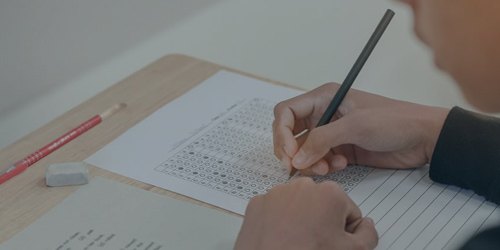Ceramic and Glass Design is a design-oriented course with a mix of different aspects of science, art, and creativity. This course is devised to focus on teaching and training its students, about the different types of materials that are used and the techniques or process of crafting a genuine artistic sculpture or design. Moreover, it also covers many technical aspects and science involved in the crafting and designing process. The beginning of this industry can be traced back to the ancient times of crafting. However, being such a historic thing, this course still has endless career scope in Engineering, Housing/Real estate and Construction, Industrial Manufacturing, etc. In the current decade, the demand for aesthetically designed products has increased, making it an integral part of the luxurious and artistic population.

What does the course focus on?
- Designing, Creating, and Manufacturing of ceramic materials
- Conducting research on ceramic materials
- Testing the chemical, physical, and heat-resisting properties of materials
- Testing the texture, durability, glazing, color, and refractory properties of finished materials
Highlights:
| Course Name | Ceramic and Glass Design |
|---|---|
| Course Level | Masters (PG), Diploma, Bachelors (UG) |
| Duration |
|
| Examination Type | Semester |
| Eligibility | Varies with course |
| Admission Process | Merit and Entrance based admission |
| Top Recruiters | Titan, Good Earth, Dovetail, Ekmatra Fashion, Micheal Aram, TATA Ceramics, Clay craft, etc |
| Top Career Scopes | Ceramics and Glass designer, AAVARAN, Ceramic Engineer, Tata ceramics, etc |
Top Colleges:
- NID Ahmedabad
- Aditya College of Design Studies
- University of Visva-Bharati
Eligibility:
| Course | Duration | Eligibility | Entrance |
|---|---|---|---|
| Diploma in Design | 1 year |
|
College Entrance |
| B.F.A in Design | 4 years |
|
College Entrance, NID Entrance Exam |
| Bachelor in Design | 3 years |
|
College Entrance, NID Entrance Exam |
| Master in Design | 2 years |
|
College Entrance, NID Entrance Exam |
Skills Required:
- Leadership skills
- Interpersonal skills
- Communication skills
- Commercial awareness
- Creative problem-solving skills
- Effective decision-making skills
- Organizational skills
- Negotiation skills
- Forward Planning skills
- Creative and zest for uniqueness
- Model making and Manufacturing
Syllabus:
The core subjects associated with the course are mentioned below:
| Subject Name | Subject Name |
|---|---|
| Enhancing the sensibility and sensitivity towards aesthetic & function of design | Fundamentals of design including form, colour, structure, space, light, etc. |
| Inputs in ergonomics for awareness in usability aspects | Work within a variety of industry, producing tableware, tiles, sanitary ware as part of Industrial Training |
| Exposure to allied materials, such as bamboo, wood, metal & leather besides core materials | Engineering Mathematics |
| Engineering Thermodynamics | Manufacturing Practice |
| Engineering Drawing | Universal Human Values - I: Self and Family |
| Basic Ceramic Practices | Manufacturing Practice - II |
| Materials Science | Ceramic Raw Materials |
| Particle Mechanics and Fluid Flow Process | Thermodynamics and Phase Equilibria in Ceramic Systems |
| Mathematical Methods | Exploratory Project(Philosophy /Education and Self) |
| Heat and Mass Transfer | Structure and Properties of Ceramic Materials |
| Ceramic Phase Diagrams and Phase Transformation | Techniques for Materials Characterization |
| Glass and Glass Ceramics Refractories | Advanced Ceramics |
| Process Calculations | Ceramic White wares |
| Glass Engineering/Advanced Refractories | Nano Technology |
| Fuel, Furnace & Pyrometry | Plant, Equipment, and Furnace Design |
| Glass Technology & Application | Steel Plant Refractories |
| Advanced Electro-ceramics | Bio-Ceramics |
| Non-Oxide & Structural Ceramics | Cement and Concrete |
| Ceramic Coating & High Temperature | Ceramic Processes |
| Pollution Control in Ceramic Industries | Industrial white wares |
| Ceramic Composites | |
Admission Process:
The interested students can apply by filling up the admission form in online/offline mode. The admission process will start after the completion of the application process. The students will then be selected through the online/offline entrance exam that will be conducted by the university or college. Only the candidates who qualify the cut-off mark will be invited for the interview and counseling rounds. However, some institutions have a merit-based admission process where the students with good marks will be given first preference.
Top Entrances:
- Duration of Exam: 3 hours
- Mode of Exam: Pen and Paper-based (PBT)
- Mode of Application: Online
Career Scope:
| Job Profile | Average Annual salary |
|---|---|
| Ceramics and Glass designer | Rs 3 - 5 lakhs |
| Ceramist | Rs 3 - 4 lakhs |
| Entrepreneur | Rs 5 lakhs onwards |
| Ceramic Engineer | Rs 2.5 - 3.5 lakhs |
Top Recruiters:
- Titan
- Good Earth
- Dovetail
- Micheal Aram
- AAVARAN
- Tata ceramics
- Clay craft
- Ekmatra Fashion
- Srijani
- Tripura Bamboo Mission Industries
Top Hiring Cities:
- Delhi
- Mumbai
- Bangalore
- Hyderabad
- Kolkatta
FAQ's
Q: What is the difference between ceramic engineering and ceramic and glass design?
A: Ceramic engineering is the science and technology of creating objects from inorganic, non-metallic materials. This is done either by the action of heat or at lower temperatures using precipitation reactions from high-purity chemical solutions while the Ceramic and Glass Design course offers tremendous expressive qualities in the domain of art and creativity as well as functional possibilities in the realm of craft, architectural spaces, healthcare, hospitality industry, home décor, hi-tech products, and lifestyle product categories.
Q: What is the scope of the Ceramic and glass design course?
A: opportunities regarding this course. Job prospective is vast and a graduate can land a job in many MNC companies as well as can work as a consultant
Q: Can a Candidate pursue a Design Degree without a science background?
A: Yes absolutely a nonscience background student can make a career in designing irrespective of the previous background.
Q: What is ceramic?
A: The products of ceramic are penetrable, hard, and delicate. So they are used to make pottery, bricks, tiles, cement, and glass. They are also used in gas turbine engines space shuttle program, ballistic protection, bio-medical implants, etc.
Q: What are the top entrances for ceramic and glass design?
A: The top entrance for ceramic and glass design is-
- NID Entrance Exam











